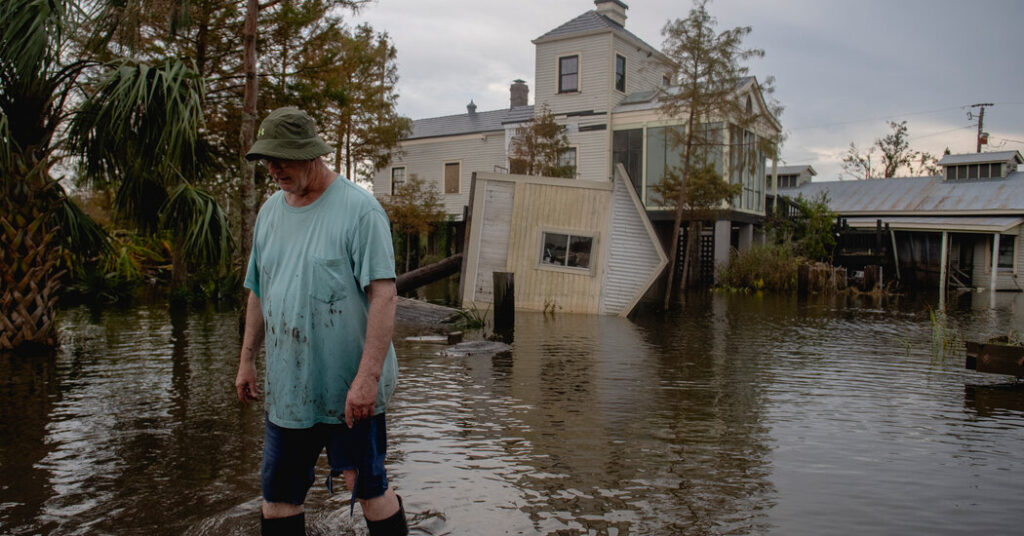Over the last few years, we’ve written about how climate change has driven home insurance prices way up for many Americans. And we’ve reported that insurers are losing money and dropping homeowners in a home insurance market that’s wildly distorted.
But now these high insurance costs are cascading into the broader real estate market, suppressing home values by an average of $44,000 in the top 10 percent of U.S. ZIP codes most vulnerable to hurricanes and wildfires.
That’s according to first-of-its-kind research that we reported on yesterday.
The researchers Benjamin Keys and Philip Mulder analyzed more than 74 million housing payments made between 2014 and 2024 to understand how much people are paying for home insurance and how insurance prices are affecting the rest of the real estate market.
They turned up some of the best evidence yet that chaos in the insurance market is starting to eat into the real estate market in some places, a scenario that experts have dreaded for years.
Read our article here and explore what’s happening with insurance costs in your area.
If you’re willing, we’d love it if you’d tell us about your home insurance experience on home insurance to help us figure out where to look next. (You can also write to us at [email protected] or respond to this email.)
Here’s what else you need to know.
Insurance costs are increasingly eating into household budgets
In some areas of the country that are exposed to disasters, homes are not selling because prospective buyers can’t afford both the mortgage and the insurance. Owning a home is thought of as a way of locking in predictable housing costs. But some of the homeowners we spoke to had seen insurance rates double or quadruple, making them wonder if they can afford to stay in homes they’ve lived in for decades.
In parts of the hail-prone Midwestern states, for example, insurance now eats up more than one-fifth of the average homeowner’s total housing payments, including mortgage costs and property taxes. In Orleans Parish, La., that number is nearly 30 percent.
Insurance costs have soared in areas exposed to higher climate risk
Nationally, insurance rates have risen by an average of 58 percent since 2018, outpacing inflation by a substantial margin. But that growth has been highly uneven across the United States.
Places that are most vulnerable to climate-related disasters like hurricanes, fires and hail are seeing some of the largest premium increases. They include parts of Colorado, coastal Louisiana and Oklahoma.
Still, it’s not always the case that the highest climate risk translates into the highest insurance costs. Local policies and regulations have helped keep prices lower in high-risk places, like parts of California. Other factors, like a homeowner’s credit score, can affect premiums, too.
What’s driving up insurance prices?
Since 2017, an obscure part of the insurance market, known as reinsurance, has helped push up premiums. Insurance companies buy reinsurance to help limit their exposure when a catastrophe hits. Over the past several years, reinsurance companies have experienced what the researchers who led the new study call a “climate epiphany.” As a result, the rates they charge to protect home insurance companies against catastrophic losses have roughly doubled since 2017.
Insurance providers have, in turn, passed these costs on to homeowners. The rapid repricing of climate risk is responsible for about 20 percent of home insurance premium increases since 2017, according to Dr. Keys and Dr. Mulder.
What else is contributing to high rates? Rebuilding costs are responsible for about 35 percent of the recent changes, the research found. Population shifts and inflation are factors, too.
High insurance rates are weighing down home values
Since 2018, this financial shock in the home insurance market has meant that homes in the ZIP codes most exposed to hurricanes and wildfires sell for less than they otherwise would have, the research found. The top 25 percent of ZIP codes exposed to disasters have seen home values decrease by an average $21,000, and the estimate for the top 10 percent is $44,000.
In many places, insurance has been a relatively small part of the home-buying equation. Now, for many, it’s a major consideration, and it’s even stopping some from buying a home.
For several homeowners we interviewed in Louisiana, monthly insurance costs are now higher than their home loan payments.
This is the scenario some real estate experts have been warning about for years. They worry that climbing insurance costs will have a domino effect, causing local real estate markets to freeze up, housing prices to decline and government services to shrink as property tax revenue falls.
Policymakers like Michael Conway, Colorado’s insurance commissioner, are trying to come up with fixes to prevent this from happening.
“We don’t want a situation where the insurance market is effectively decimating the real estate market,” he said.
50 States, 50 Fixes
Iowa City made its buses free. Traffic cleared, and so did the air.
Iowa City eliminated bus fares in August 2023 with a goal of lowering emissions from cars and encouraging people to take public transit. The two-year pilot program proved so popular that the City Council voted this summer to extend it another year, paying for it with a 1 percent increase in utility taxes and by doubling most public parking rates to $2 from $1.
Ridership has surpassed prepandemic levels by 18 percent. Bus drivers say they’re navigating less congested streets. People drove 1.8 million fewer miles on city streets, according to government calculations, and emissions dropped by 24,000 metric tons of carbon dioxide a year. That’s the equivalent of taking 5,200 vehicles off the roads. — Cara Buckley
Read more. And read more from our 50 States, 50 Fixes series:
-
In Nebraska, Makeovers for Buildings That Don’t Price Out the Locals
-
They Loved Their Family Land in South Carolina. But Who Actually Owned It?
-
Driving an E.V. Across North Dakota? Thank the Standing Rock Tribe
-
In Washington, Birds Are Giving ‘Yelp Reviews’ of Forest Restoration Work
Wildlife
Trump moves to weaken the Endangered Species Act
The Trump administration proposed on Wednesday to significantly limit protections under the Endangered Species Act, the bedrock environmental law intended to prevent animal and plant extinctions.
The four proposed new rules could clear the way for more oil drilling, logging and mining in critical habitats for endangered species across the country.
One of the most contentious proposals would allow the government to assess economic factors, such as lost revenue from a ban on oil drilling near critical habitat, before deciding whether to list a species as endangered.
The proposals largely resemble changes that the first Trump administration made to the Endangered Species Act in 2019 that were reversed under the Biden administration. — Maxine Joselow and Catrin Einhorn
Lost Science
‘There was no warning, no conversation.’
Jane Clougherty, an environmental health scientist and professor at Drexel University in Philadelphia, had a federal grant to study how heat and pollution can affect children. Clougherty and her team were trying to determine the best and most cost-effective ways of keeping children out of the emergency room because of extreme heat or bad air quality. They analyzed data on 22 million child emergency department visits and hospitalizations, along with U.S. census information. In May, the Environmental Protection Agency eliminated their grant.
Read more. And read more from our Lost Science series.
More climate news from around the web:
-
One of China’s top climate policy advisers told The Guardian that the country doesn’t want to take the global lead on climate issues without the United States.
-
An analysis by ProPublica and The Guardian estimates the long-term human toll of President Trump’s climate policies. The analysis shows that “extra greenhouse gases released in the next decade as a result of Trump’s policies are expected to lead to as many as 1.3 million more temperature-related deaths worldwide in the 80 years after 2035.”
Thanks for being a subscriber.
Read past editions of the newsletter here.
If you’re enjoying what you’re reading, please consider recommending it to others. They can sign up here. Browse all of our subscriber-only newsletters here. And follow The New York Times on Instagram, Threads, Facebook and TikTok at @nytimes.
Reach us at [email protected]. We read every message, and reply to many!
Claire Brown covers climate change for The Times and writes for the Climate Forward newsletter.
The post Home Prices on a Warming Planet appeared first on New York Times.




